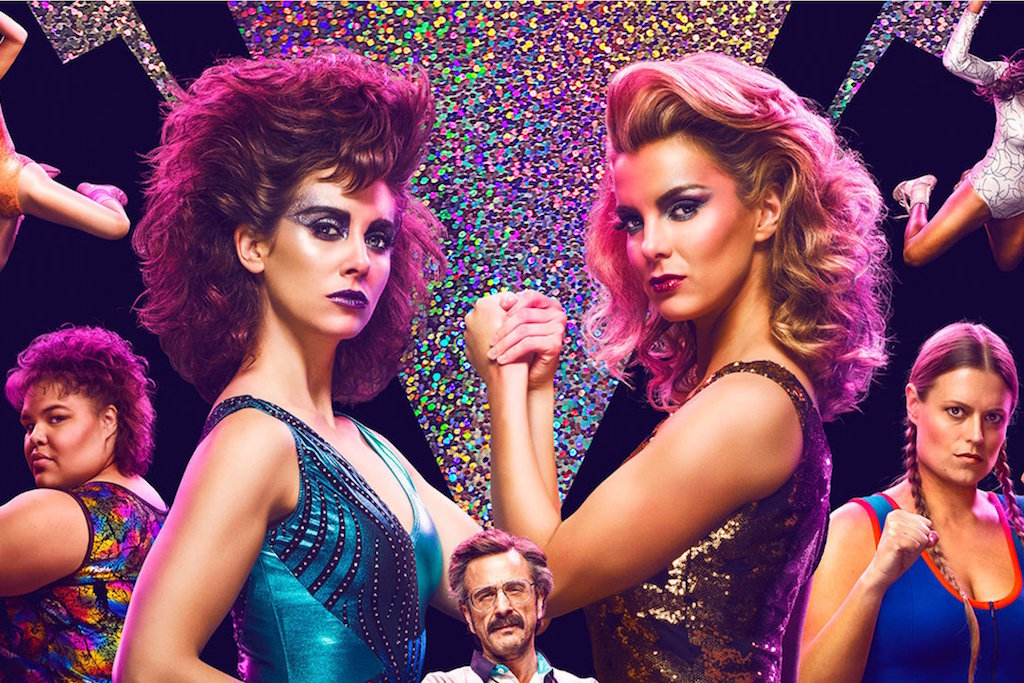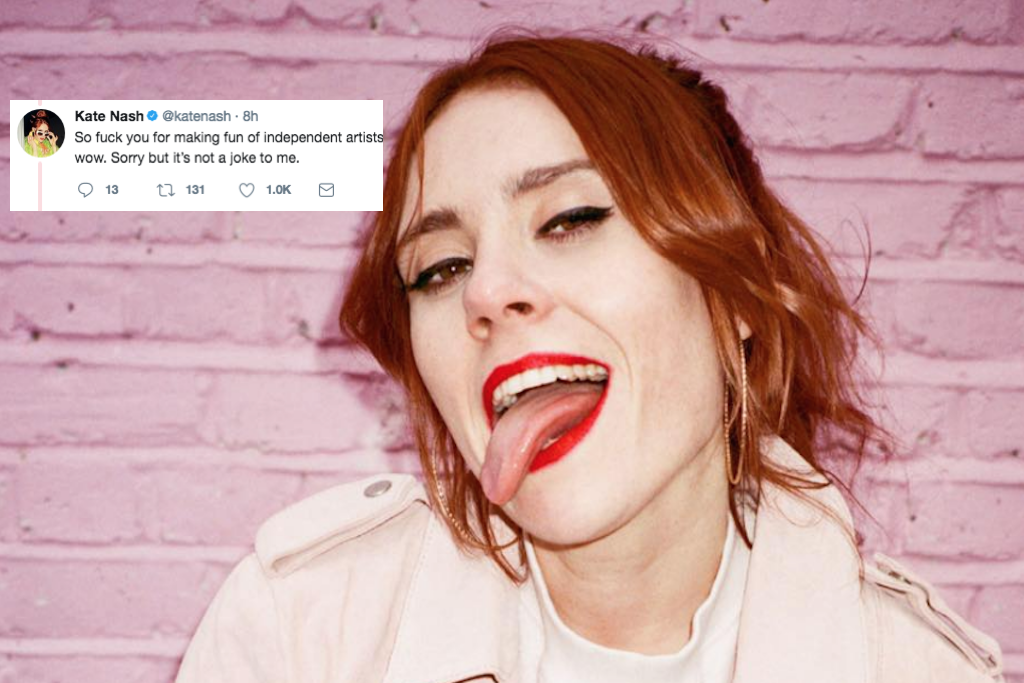It’s Time To Give Kate Nash The Credit She Deserves
She's a whole lot more than her Foundations.

When Kate Nash re-emerged as Rhonda “Brittanica” Richardson on Netflix’s GLOW in mid-2017, it was a part of an impressive comeback trail for the English singer-songwriter.
Holding her own against big comedy names like Community‘s Alison Brie and WTF‘s Marc Maron, Nash was hailed as one of the true stars of the series. At the same time, she was preparing to make her first album in years — and, thanks to a wildly successful Kickstarter, ended up with twice the budget she needed.
Fast forward to present day, and the Kate Nash reniessance is in full swing. The album in question, Yesterday Was Forever, hit shelves last month. In June, GLOW will return for its second season. In between all of that, Nash has just finished a successful North American tour — with the rest of the world to follow.
So what has Nash filled her days with in the decade since she first found stardom? Where is she headed next? And most importantly: is ‘Foundations’ still a banger?
It’s time to reflect on the story of Kate Nash thus far — and to give her the credit she deserves.
Setting The Foundations
Before we go any further, let’s take into consideration that Nash is 30-years-old now. Doing a bit of Big Shaq-approved quick maths, that means Nash was barely out of her teens when her debut album, 2007’s Made of Bricks, was recorded — and still in them when most of it was written.
It’s full of youthful exuberance and naïvete you’d expect from a performer at such an age: “I’ve got a family/And I drink cups of tea,” she opines in ‘Mouthwash’. Even so, the amount of agency Nash holds as a songwriter and performer here is well beyond her years — she holds at least a co-write on every single song, plays almost every instrument and asserts an identity for herself at a time in one’s life where most don’t really know who they are at all.
Even with its flaws and its oft-cheesy lyrics, Made of Bricks remains one of the more charming debuts of the era. ‘We Get On’ is painfully-relatable piano-pop about a blossoming crush gone awry, ‘Pumpkin Soup’ is antithetical to its title insofar as it’s pure bubblegum, and the bare acoustic confessional ‘Nicest Thing’ is genuinely moving as its cello accompaniment swells to match Nash’s emotive peaks. There’s also ‘Mariella’, a building-tempo pop-rock hybrid inspired by a child Nash used to babysit that ended up as one of the best songs in her arsenal.
As great as all these are, they obviously live in the shadow of ‘Foundations’, Nash’s signature song. A deceptively-sunny sing-speak ode to a passive-aggressive relationship, Nash hit onto something in the twenty-something psyche that allowed the song to maintain at least a degree of legacy for a solid decade after its release. Whether it’s the fluttering drum machine, the effectively-simple chordal loop or the snarky lyrical asides, you can’t help but love ‘Foundations’.
Is it her best song? Not necessarily. It may, however, be the most important one she has — after all, if anyone knows a Kate Nash song, it’s this one.
Difficult Second Albums And Real Friends
After a breakdown that came with exhaustively touring Made of Bricks for over a year, Nash needed time away to recalibrate and refocus.
It was always going to be a challenge to match up to the adoration that Bricks had received, and the stigma of “second album syndrome” was inevitable no matter what the record turned out like. 2010’s My Best Friend is You didn’t get all that much love at the time — publications like The Independent and Uncut were particularly mean about it, calling it “gauche” and “rubbish.” In comparison to the platinum sales of Made of Bricks in the UK, Best Friend didn’t even go gold.
So, what are Best Friend‘s weak spots? In all honesty: it’s the parts that sound the most like Kate Nash. As lovely and catchy as tracks like ‘Do-Wah-Doo’ and ‘Kiss That Grrrl’ are, they were clearly picked as singles to mirror the sound established on Bricks. They’re crowd extras, not leading ladies.
In truth, the best moments on My Best Friend is You are when Nash becomes legitimately terrifying. When she lets out a Kathleen Hanna-esque shriek over the robust garage-rock of ‘I Just Love You More’, it’s a shock to the system after the robotic sprechgesang in the verses that repeats the titular mantra ad infinitum. It hooks you in and keeps you on board for the rest of the song.
Later, Nash is channelling her inner John Cooper Clarke with her expletive-laden poetry in ‘Mansion Song’. You can hear the bitterness in her voice as she sneers “I read Glamour/And The Guardian,” name-checking the latter seemingly as a spitting retort to their scathing Bricks review some years prior.
It’s a scorched-earth damnation of groupie culture and the quickness of women to tear one another down at the hands of the patriarchy: “Fuck, get fucked and drag/And be impressed/By the better sex.” Nash sounds furious in ‘Mansion Song’, and to even think of Nash writing something furious a few years before this was out of the question.
Talking The Talk And Walking The Walk
Unsurprisingly, Nash was not long for the majors following My Best Friend is You.
Having previously been a part of Universal (via imprint Fiction Records), Nash moved on as an independent woman of the 21st century — as ‘Mansion Song’ had previously prophesised. She abandoned the piano, her signature instrument, and took to playing bass instead. She enlisted an all-female backing band and started championing the then-imprisoned Pussy Riot.
She wrote and recorded a single, ‘Under-Estimate the Girl’, in less than 24 hours — its accompanying music video over a half-million views and, fittingly, nearly two-and-a-half thousand dislikes. Not that Nash gave a fuck – in this new era, she wasn’t seeking approval or trying to please any higher-ups.
It was a liberation that translated to her two subsequent releases, the 2012 EP Death Proof and the 2013 LP Girl Talk — the latter of which was made possible by the use of PledgeMusic.
Whatever Nash wanted to do, she would go out and do it. This included covering The Kinks (‘All Day and All of the Night’) and FIDLAR (changing their “Cocaine” into “Girl Gang”). It meant brisk, catchy songs like ‘Fri-End?’ and ‘3AM.’ It meant following initiatives like “Kate Nash’s Rock n Roll For Girls After School Music Club,” which pretty much did exactly what it said on the tin.
A lot of it was met with apprehension – Rolling Stone claimed that Nash’s “punk postures” were “borrowed from musicians smarter and more talented” in their blunt Girl Talk review. Nevertheless, she persisted — after all, that same album contains the manifesto “I’m a feminist/And if that offends you/Then fuck you.”
If nothing else, Death Proof and Girl Talk are to be admired for their moxie and their confidence.
Yesterday And Today
When Nash was setting out to make Yesterday Was Forever, her initial goal was US$70,000. By the end of her crowdfunding campaign, the total money pledged was US$155,412 — well over double what she was asking.
It’s a testament to how far Nash has come as an independent artist and as a musician in general that she’s held onto such a remarkably-dedicated fanbase. It’s truly something to fully appreciate how much Nash’s connection with her fans has allowed her to survive when other major-label dropouts have routinely floundered.
With the release of Yesterday Was Forever, Nash comes full circle — she entered the music industry as a boofy-haired and bright-eyed 20-year-old starlet, and a decade later she is more confident and unabashed about who she is than ever before.
The album is a surprising mixed bag — not a total abandonment of her Riot grrrl garage days, but neither is it a simplistic retread. Instead, Yesterday feels more all-encompassing — it draws elements from all of her previous LPs and incorporates some new tricks along the way. It flirts with slicker production and poppier hooks just as much as it does with open-book honesty and a resonant sense of vulnerability within Nash’s lyrics.
It’s an album that feels liberating for an artist such as Nash — it’s reclamation, reinvention and reincarnation all at once. Much like its title, it’s paradoxical — but intriguingly so.
It’s the sound of an artist that built their own foundations, tore them down and rebuilt an empire. It might not seem as bright and shiny to the everyday passerby, but for Nash it’s a personal paradise.
That’s the ultimate take-away — Kate Nash knows exactly who she is and what she wants, critics be damned. What more could you ask for from an artist?
—
David James Young is a writer, podcaster and a dickhead. Sometimes, he tweets: @DJYwrites.

